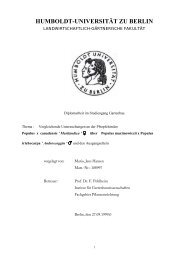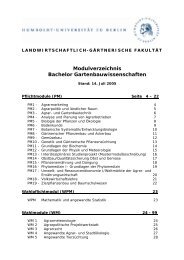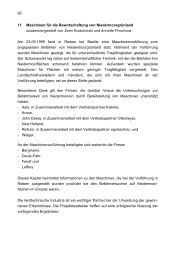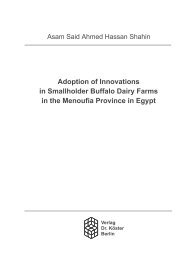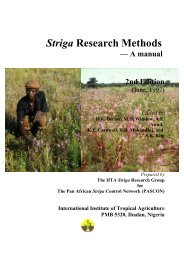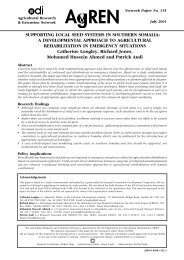Rice-Wheat Cropping Systems of the Indo-Gangetic Plain of India
Rice-Wheat Cropping Systems of the Indo-Gangetic Plain of India
Rice-Wheat Cropping Systems of the Indo-Gangetic Plain of India
Create successful ePaper yourself
Turn your PDF publications into a flip-book with our unique Google optimized e-Paper software.
March. Thirdly, in districts with<br />
comparatively deficient soil moisture<br />
availability, such as Gurgaon and Faridabad,<br />
a sizeable area is sown to barley, oilseeds<br />
(canola and mustard) and chickpea crops.<br />
Besides, <strong>the</strong> fodder crop <strong>of</strong> berseem<br />
(Trifolium alexandrinum), raised for dairy<br />
cattle, also accounts for appreciable area all<br />
over Haryana. Even <strong>the</strong>n, <strong>the</strong> wheat area<br />
is higher than <strong>the</strong> area devoted to rice in<br />
this region, to <strong>the</strong> extent <strong>of</strong> almost oneand-a-half<br />
times.<br />
Agroclimatic Region V: Upper <strong>Gangetic</strong><br />
<strong>Plain</strong> Region (Uttar Pradesh)<br />
ACZ B1, B2, B3 and B4—Western <strong>Plain</strong>,<br />
Bhabar and Tarai, Mid-Western <strong>Plain</strong>,<br />
Central <strong>Plain</strong> and South-Western Semi-<br />
Arid Zones <strong>of</strong> Uttar Pradesh: After <strong>the</strong><br />
Trans-<strong>Gangetic</strong> <strong>Plain</strong> Region,<br />
agroclimatically, <strong>the</strong> Upper-<strong>Gangetic</strong> <strong>Plain</strong>s<br />
Region, forms <strong>the</strong> most natural wheatgrowing<br />
area <strong>of</strong> <strong>India</strong>. This region, like <strong>the</strong><br />
former, besides receiving ample winter rains<br />
(80–100 mm), also enjoys abundant<br />
irrigation water availability. It has deep,<br />
well-drained alluvial fertile soils. The region<br />
has a well-developed infrastructure; like<br />
rail, roads, transport, communications,<br />
electricity, a vast network <strong>of</strong> canal and<br />
tubewell-based irrigation systems, and an<br />
easy access to markets. Fertilizers and o<strong>the</strong>r<br />
inputs, a fairly high level <strong>of</strong> agro-technology<br />
and credit are readily available.<br />
The density <strong>of</strong> wheat, though quite<br />
high is comparatively less than in <strong>the</strong> Trans-<br />
<strong>Gangetic</strong> <strong>Plain</strong>s. The density <strong>of</strong> wheat area<br />
is high around Tarai in B2, <strong>the</strong> Western<br />
(B1), Mid-Western (B2) and adjoining<br />
districts <strong>of</strong> South-Western Semi-Arid Zone<br />
(B4). It tends to be less in <strong>the</strong> Bhabar<br />
<strong>Plain</strong>s Tract and thins out fur<strong>the</strong>r in lower<br />
districts <strong>of</strong> dry zone B3, obviously due to<br />
<strong>the</strong> water availability constraint.<br />
In Western Uttar Pradesh, and in<br />
Tarai regions <strong>the</strong> main competition to wheat<br />
comes from sugarcane, while in <strong>the</strong> dry<br />
zone, low water requiring crops like canola<br />
and mustard, winter legumes such as<br />
chickpea, mixed crops, etc. are cultivated<br />
during rabi.<br />
The cultivation <strong>of</strong> wheat though quite<br />
widespread in <strong>the</strong> Central <strong>Plain</strong> Zone (B3),<br />
tends to be comparatively less than that in<br />
ACZs B1, B2 and B4. This is primarily due<br />
to water availability constraint. The canal<br />
irrigation is not vastly developed nor is<br />
tubewell irrigation widespread in this zone.<br />
The north-west monsoon rains also taper <strong>of</strong>f,<br />
<strong>the</strong>reby, leaving overall a net deficit water<br />
balance. Secondly, large-scale cultivation<br />
<strong>of</strong> long-duration pigeonpea in this zone<br />
prevents planting <strong>of</strong> wheat in time.<br />
Therefore, wheat area thins out<br />
considerably in <strong>the</strong> Central <strong>Plain</strong> Zone (B3)<br />
in comparison to that observed in ACZs B1<br />
and B2.<br />
Agroclimatic Region IV: Middle<br />
<strong>Gangetic</strong> <strong>Plain</strong> Region (Eastern<br />
Uttar Pradesh and Bihar)<br />
Sizeable area <strong>of</strong> wheat is observed in <strong>the</strong><br />
Middle-<strong>Gangetic</strong> <strong>Plain</strong>s Region, as well.<br />
But this is largley concentrated in eastern<br />
Uttar Pradesh. The density <strong>of</strong> wheat<br />
cultivation tends to thin out from <strong>the</strong> west<br />
to <strong>the</strong> east <strong>of</strong> <strong>the</strong> region. The state <strong>of</strong><br />
Bihar, though showing sizeable area under<br />
wheat, has a comparatively thinner spread<br />
<strong>of</strong> area in <strong>the</strong> north-eastern and sou<strong>the</strong>rn<br />
flanks. Agroclimatically, <strong>the</strong> Bihar IGP<br />
region has mild winters and, <strong>the</strong>refore, has<br />
a ra<strong>the</strong>r shorter wheat-growing span. In<br />
fact, <strong>the</strong> growing season <strong>of</strong> wheat tends to<br />
be shorter by almost 30–35 days as<br />
compared with that <strong>of</strong> <strong>the</strong> Trans-<strong>Gangetic</strong>/<br />
Western Uttar Pradesh regions. The abrupt<br />
rise <strong>of</strong> temperatures in spring which <strong>of</strong>ten<br />
causes terminal heat stress, fur<strong>the</strong>r curtails<br />
<strong>the</strong> growing period. This enforced maturity<br />
results in imperfectly developed or<br />
21



